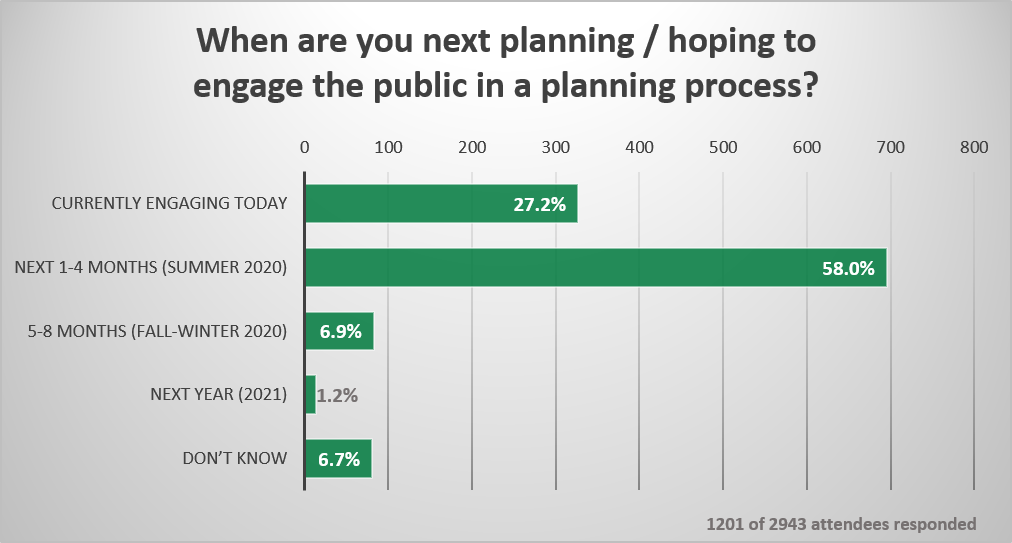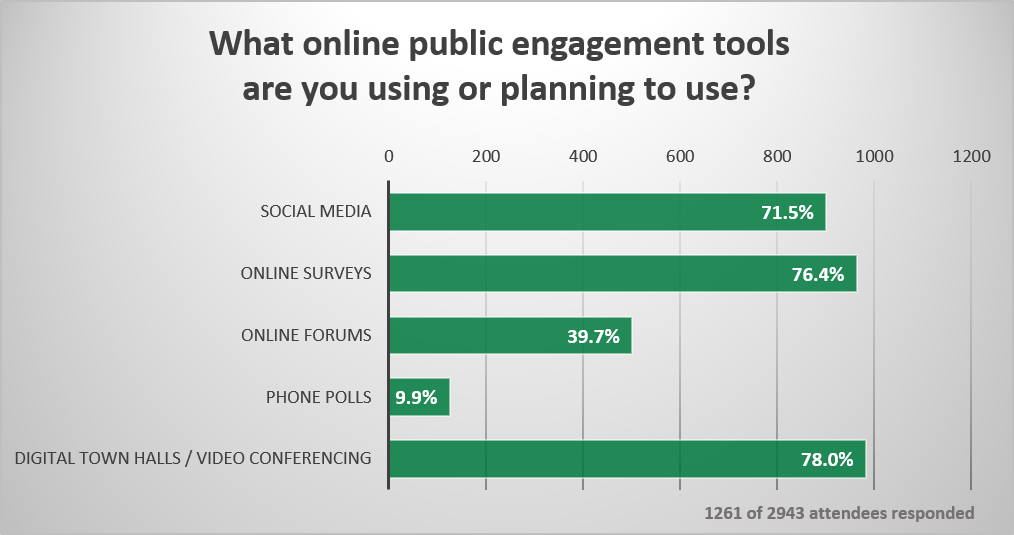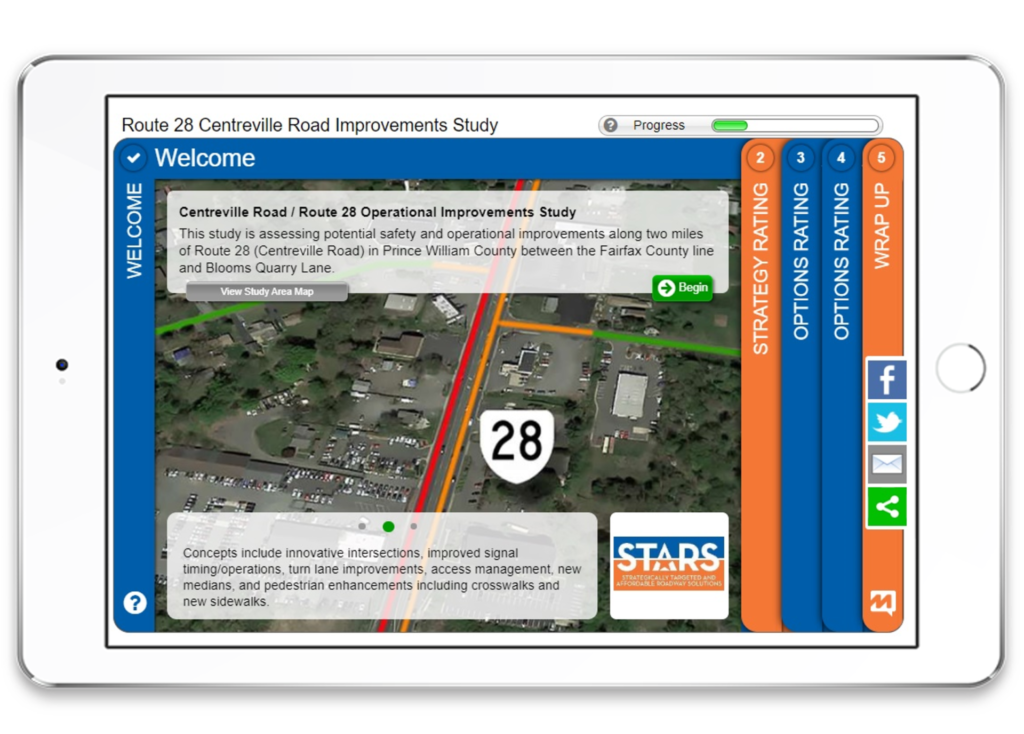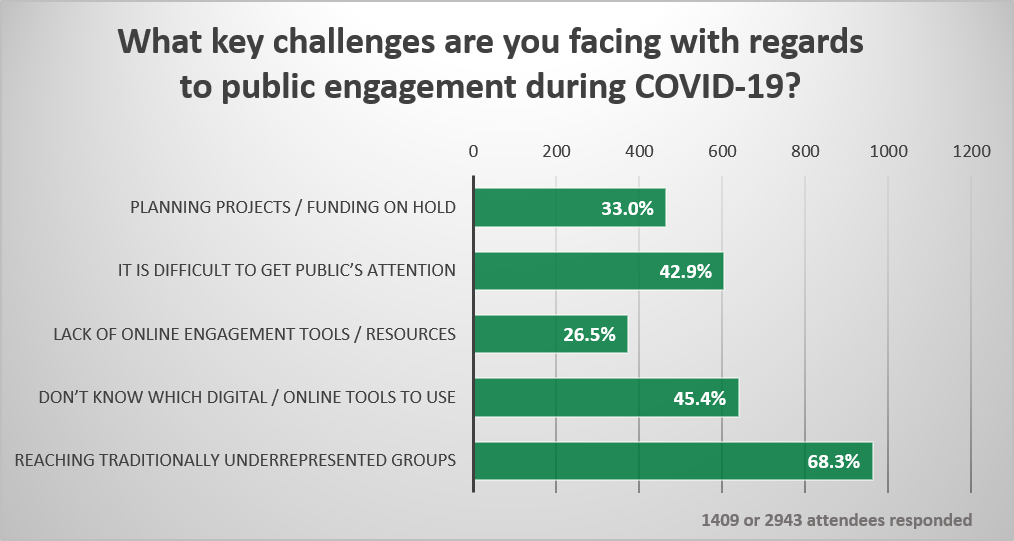How Planners are Taking Public Engagement Online During COVID-19

No one planned for this pandemic. With so many urban and transportation planning projects under way for 2020, are plans still moving forward? The nationwide mandate for social distancing resulted in the cancellation of thousands of public meetings. How can agencies meet their public engagement requirements now?
The COVID-19 outbreak has raised a lot of questions. We turned to you for answers.
Last week, over 4,760 planners and public participation professionals registered for our webinar “Reimagining Public Engagement for Planning During COVID-19: A Peer-to-Peer Exchange.”
Using live polls and questions, we learned how you and your peers are adapting to maintain momentum. We also explored case studies, strategies, and best practices with our guest panel speakers: Stephen Stansbery from Kimley-Horn, Shane Sawyer from the Virginia Department of Transportation (VDOT), and Bob Bini from Lancaster County. Stephen, Shane, and Bob shared the techniques and tools they’re using to keep key projects moving forward over the next 18 months. Thank you for all your insights! Let’s spotlight what we learned.
YES! Most urban and transportation planning projects are moving forward, despite COVID-19.
There is some disruption, with 33.0% of 1,409 poll participants noting their planning projects or funding have been put on hold. And yet, the vast majority are charging forward with public engagement.
Over 1,200 planners and public participation professionals answered the poll question: “When are you next planning / hoping to engage the public in a planning process?” It was uplifting to learn that 85.2% currently are or plan to engage the public in planning over the next four months, with very few waiting for the fall.
Bob Bini as Director for Transportation Planning for Lancaster County, Pennsylvania is among those charging forward with transportations projects aimed at improving safety and reducing congestion. While traffic may not be an issue today, Bob oversees planning activities for the Lancaster County Metropolitan Planning Organization (MPO), including the development of a new Metropolitan Transportation Plan, Connects 2040, and the management of the biennial Transportation Improvement Program. He is responsible for what will soon again be one of the most heavily traveled highway networks in Pennsylvania.
“There are key deadlines with our comprehensive plan,” noted Bob in the webinar. “So, it’s important that we keep these activities moving even through these times and we are managing to do that.”
Bob is true to his word. In his recent Connects 2040 MetroQuest survey, his team engaged 2,837 residents, capturing over 78,250 data points to better inform the Lancaster 2040 Metropolitan Transportation Plan.
With public meetings on hold, what are the most popular tools for online public engagement?
Bob isn’t holding public meetings. Neither are Shane nor Stephen. Like thousands of their peers, they turned to online tools and digital engagement to continue to involve the public in support of their projects. In a live poll, we learned that the three most popular online tools today are: (1) digital town halls held via video conferencing, (2) online surveys, and (3) social media.
All three webinar panel speakers are seeing great success with these online tools. For instance, as Multimodal Programs Manager at the Virginia Department of Transportation, Shane Sawyer is posting meeting-like videos on his project webpages to keep the public informed – you can take a look at his Route 60 Corridor Study webpage here →
To collect public input, Shane has consistently achieved success by combining targeted social media and online surveys. While newspaper ads previously cost his department thousands of dollars followed by meager attendance at public meetings, his team is now able to use just $200 in Facebook advertising to promote its MetroQuest surveys with great results.
“We have been effectively utilizing a range of virtual public involvement techniques for planning studies,” Shane told us, including MetroQuest surveys. “Corridor studies are very limited in geographic scope, usually around two miles or so. Getting 500, 600, even some cases nearly 2,000 folks to fill out a survey has exceeded our expectations! We’ve been very impressed with online engagement.”
In a recent MetroQuest survey for the Route 28 Centerville Road Improvements Study, VDOT engaged 698 residents, collecting 24,091 data points and 22,513 option ratings to better inform a data-driven plan. You can try his MetroQuest survey here (no data will be collected from this demonstration-only copy).
For planners transitioning to online engagement, Shane also recommended the virtual public involvement resources made available by the Federal Highway Administration.
Building the right toolbox for online public engagement remains a challenge.
Another poll confirmed some key challenges facing 1,409 planners and public participation professionals, with 71.9% noting they either don’t have online engagement tools or don’t know which ones to use for safe, effective public engagement in planning.
We explored this challenge in a recent blog post, “5 Reasons Planners Need a Unique Online Public Engagement Toolbox.” For more information on this, you can also join our own Chief Engagement Officer, Dave Biggs, as he explores the online engagement options and shares some of MetroQuest’s best performing case studies next week in the webinar “Optimizing Public Engagement for Planning with MetroQuest.”
Those with a keen eye for data will have noticed in the chart above that “reaching traditionally underrepresented groups” also remains a top public engagement challenge, particularly during COVID-19. Stephen Stansbery, AICP, Vice President at Kimley-Horn & Associates offered great advice during last week’s webinar.
“In the era of geofencing and those sorts of technologies, we have the ability to zero in geographically into the specific cohorts that we want to ensure that we’re elevating,” said Stephen. “And I think one thing that we don’t want to lose sight of is the effectiveness of representative groups, whether a committee, an advisory group, or even a paid online focus group. We’ve been working with clients that have found incredible value in ensuring that we’ve got a specific set of constituencies assembled for the purposes of asking questions related to the relevancy to those traditionally underrepresented and underserved populations.”
Shane from VDOT agreed, recommending social media targeting as a solution. “I think by default you’re going to reach a larger and more diverse demographic. It can be very cost effective, and it can be targeted as well. We often use zip codes to target populations to try to reach folks who are not likely to come out to a public meeting. Social media can be very effective.”
To learn more, contact us today or watch the on-demand webinar: Reimagining Public Engagement for Planning During COVID-19: A Peer-to-Peer Exchange.
Reimagining Public Engagement for Planning During COVID-19: A Peer-to-Peer Exchange
COVID-19 is changing the way planner and public participation professionals are engaging the public. This webinar highlights how 1,000s of your peers are managing to maintain momentum.




